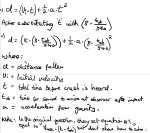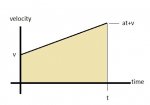Hi,
The question posed is:
A person looking out of a window of a tall building sees a bucket fly past the window at 30 m/s, then hears the bucket hit the ground 8 seconds later. At what altitude is the observer located? Assume negligible air resistance and speed of sound at 340 m/s.
The problem I am having is that the sound takes an unknown time to arrive at the observer after hitting the ground.
Using the common kinematic equations and substitution, I have built a couple of formulas:

What are the steps using my equation, if correct? I haven't managed to do it.
Or, how do I solve it after setting equation#1 equal to velocity * (total time - time for sound to reach observer)?
I have found various equations for solving similar penny/stone in the well problems , but they all assume a starting velocity of zero.
As an additional question, what area of algebra should I practice here, in order to solve equations like this?
Thanks!
The question posed is:
A person looking out of a window of a tall building sees a bucket fly past the window at 30 m/s, then hears the bucket hit the ground 8 seconds later. At what altitude is the observer located? Assume negligible air resistance and speed of sound at 340 m/s.
The problem I am having is that the sound takes an unknown time to arrive at the observer after hitting the ground.
Using the common kinematic equations and substitution, I have built a couple of formulas:
What are the steps using my equation, if correct? I haven't managed to do it.
Or, how do I solve it after setting equation#1 equal to velocity * (total time - time for sound to reach observer)?
I have found various equations for solving similar penny/stone in the well problems , but they all assume a starting velocity of zero.
As an additional question, what area of algebra should I practice here, in order to solve equations like this?
Thanks!


